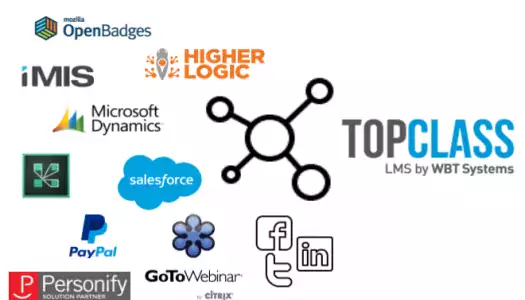During the selection and implementation of a learning management system (LMS), you have many decisions to make. But one decision often takes associations by surprise:
Should you host your eLearning catalog and eCommerce on your LMS or on your association management system (AMS)?
Where do you want members and customers to search for online learning programs and where do you want them to make their purchase (register/enroll)—in your LMS or in your AMS?
Before you can answer that question, let’s make an assumption: your AMS and LMS are integrated. First, we’ll explain why integration is advisable and then we’ll explore some issues you need to consider before deciding where to host your eLearning catalog and eCommerce.
Benefits of AMS/LMS integration
AMS/LMS integration is the best-case scenario. Hopefully you’ve found an LMS with a secure, off-the-shelf, two-way integration with your AMS so you can easily manage upgrades of both systems in the future. By the way, our TopClass LMS offers a turnkey integration with Personify, iMIS and other leading AMS solutions as well as Salesforce and Microsoft Dynamics. Just sayin’.
The AMS is the hub of your association’s technology ecosystem and contains master records for your members, customers, and prospects. You don’t want to recreate those records in different systems. With integration, the appropriate data from the AMS flows into the LMS and vice versa. Integration allows for a deeper understanding of each member because you can get a 360-view in one place. You have the data at hand to pull comprehensive reports for analytics and decision-making.
You can provide a better user experience because integration allows for Single Sign-On. Once a user is logged in on your association’s website, they stay logged in when using the LMS. The AMS authenticates the user as a member or non-member so the appropriate pricing and viewing permissions can be applied to their experience.
The big decision: where to host your eLearning catalog and eCommerce
In most cases, transactions and data can be processed and stored in either the AMS or the LMS. However, you have to choose one of them for hosting both your eLearning catalog AND eCommerce. If you try to separate those functions, you get into the lengthy and costly weeds of customization.
There’s no right or wrong approach to the hosting question—every association has different needs. Here are the issues to consider before deciding whether online course purchases should go through the eCommerce functionality of your AMS or through the eCommerce solution native to your new LMS.
eLearning catalog and eCommerce hosting considerations
Before making a decision about where to host your eLearning catalog and eCommerce, think through these issues.
Built-in or third-party eCommerce
Many LMS platforms offer an eCommerce functionality, but if you decide to go that route, make sure eCommerce is built-in—like it is in our TopClass LMS. You’ll find that the eCommerce in some LMS platforms is run through an external, third-party system (like Shopify) which requires an additional integration to implement and manage.
Branding
Because members and customers are used to purchasing association products and services through the existing AMS catalog and eCommerce platform. Will they feel ‘at home’ if the online education catalog is hosted on the LMS?
That won’t be a concern if the visual design of your LMS is branded to match the look and feel of your existing website. If the branding matches, when customers browse the LMS catalog, they won’t even know that technically they’ve left your website.
Catalog search
Your course or educational catalog should ‘reside’ in the same place as your eCommerce system. If you want to host them on separate systems, i.e., one on your AMS and one on your LMS, you’ll most likely have to customize the integration.
When it comes to searching the catalog, we have to give the edge here to the LMS catalog. An AMS catalog can work too, but only if it’s as robust in functionality, for example, in filtering or description capabilities. Work through a thorough demonstration of the AMS catalog to make sure it meets your users’ expectations and needs.
The AMS catalog may have an advantage if it has a federated search capability, i.e., it allows a search of tagged website items in addition to educational products. Federated search can often be added to an LMS catalog functionality through customization.
Checkout experience
Your association’s online shopping experience doesn’t operate in isolation. Members and customers have been spoiled by the shopping and checkout experience they have on other websites—websites with huge budgets dedicated to improving the user experience.
Test the checkout experience using the AMS as the catalog and eCommerce host and using the LMS as the host. How intuitive is the process? How many clicks does it take to make a purchase? When using an AMS shopping cart, the customer often has to click multiple times before they’re in the course. With an LMS, like TopClass, it only takes one or two clicks to enroll and start learning.
One advantage of having the LMS as host: If someone is enrolled in a certification program, they can see required or recommended courses on their dashboard, and can easily purchase a course from that screen. That functionality would require a customization if you’re using an AMS for eCommerce.
Discounts, bundling, and credits
Every AMS and LMS has different selling capabilities. Find out what you can do with the eCommerce systems of your existing AMS and the LMS you have in mind.
- Can you provide discounts?
- Can customers use promo codes?
- Can customers use tokens or credits?
- Can you bundle or package products together for a lower price?
TopClass eCommerce can do all these things—make sure the eCommerce system you have in mind does too.
Cross-sells and upsells
Decide what promotional capabilities are most important for your association and know what’s possible in each system. For example, if your LMS is hosting, can non-members be prompted to purchase a membership and receive the lower member price? If your AMS is hosting, can it make recommendations to purchase related products, i.e., upsell?
Tracking learner history
The LMS catalog and eCommerce may have an edge when it comes to tracking a user’s complete learning history, managing prerequisite requirements, and managing the certification process. The TopClass LMS has full tracking of training history, certification progress, and certificate details. Because TopClass also does event management which many LMS don’t, conference attendance can also be tracked through the LMS eCommerce.
Social sharing
Can customers share and recommend eLearning products to their peers via their social networks? Having that option further extends your reach. Know what type of social sharing is possible in both systems. Does the AMS catalog have that functionality? TopClass supports social sharing of content from the public catalog.
Learner access to products
How soon can someone start their online learning experience? If they’re raring to go, can they? If the AMS eCommerce is used, will your LMS receive data about purchases in real-time? If integration is real-time, the LMS will have what it needs and your customer is on their way.
But what if customers have to wait until an AMS batch process updates the LMS with new data about purchases? Sometimes batches are only run once a day. In that case, the customer has to wait.
Financial data
Your accounting department may prefer to have the AMS host eCommerce so they have eLearning, membership, and event financial data in one place. Is that a critical issue or resolved by improved reporting practices?
Reports
Can you get the reports you need from both eCommerce systems? Is one better than the other in that respect? Are the reports you need part of the baseline or do you need to build customized reports?
eLearning catalog and eCommerce hosting trade-offs
Were you hoping we’d give you a straight answer? Maybe we’d say, “Host your eLearning catalog and eCommerce on the LMS.” Nope. Instead, we’re giving you what everyone calls the consultant answer: “It depends.” There’s no right answer to this question which is why we shared some of the issues you need to consider before making your decision.
Before you even get to this decision, make sure you’ve identified and prioritized your LMS requirements. Know what functionality you value most. Know which parts of the user experience—for both learners and staff—are ‘must-haves’ and which are ‘nice-to-haves.’
Don’t be afraid to change one of your existing processes to get the results you want. Changing anything is always difficult, especially for staff who are used to doing something a certain way, but in the long-term, these changes can lead to improved productivity.
Talk to your AMS and LMS vendors. Identify clients who use both systems, ideally one client who’s using the AMS eCommerce and one who’s using the LMS eCommerce. Ask for a demo of their system so you can see how it looks and works in real life.
Decide what limitations you’re willing to live with and what you can’t live without. Which functionalities that enhance the learner experience are must-haves and which are merely nice-to-haves?
You might be surprised to learn that sometimes we believe choosing the AMS eCommerce and catalog is the best decision for an association, and sometimes the LMS solution is best. It depends! If you’re still unsure which way to go, contact us and we’ll talk you through it.








